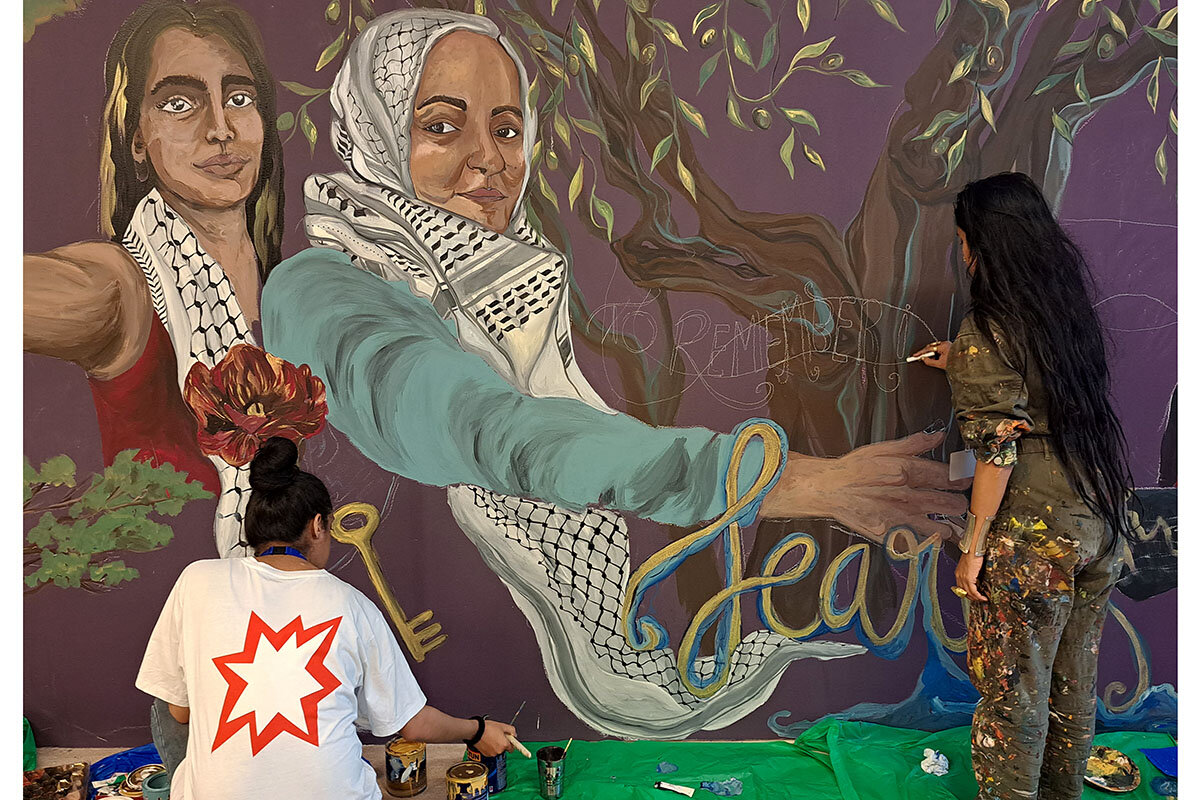In Gaza’s shadow, a climate summit on war and peace
Loading...
| Dubai, United Arab Emirates
Protest chants at this week’s global climate summit have been dominated by calls for a cease-fire as well as for cutting carbon. People are focused not just on 1.5 – the threshold degrees, in Celsius, of warming set by the Paris Agreement that the world is at risk of overshooting – but also on 14,000, the number of Palestinians reported killed in Gaza.
Activists from as far away as Colombia and the Marshall Islands are setting their eyes on militaries and war along with big oil as major spoilers to climate progress.
In more ways than one, the issue of war and peace has arrived at the United Nations’ annual Conference of Parties (COP) on climate here in Dubai. Simply put, policymakers and activists say conflict and climate can no longer be treated as separate issues in a fragile world reeling from both.
Why We Wrote This
The Israel-Hamas war has reached even into this week’s global climate summit. But some say that’s appropriate. Worldwide, addressing climate change can create conditions for peace.
To a degree not seen in the prior 27 COP meetings, participants are highlighting the need to collaborate proactively to prevent climate and conflict from feeding on each other, both now and in the hotter future that scientists predict for the planet. For leaders here, this means, for one thing, looking to boost climate adaptation and resilience for at-risk communities and to address climate stressors before they exacerbate or reignite conflict.
The next step, many COP28 participants say, is to ensure pledges are translated into change on the ground.
“The focus placed this year on fragile and conflict affected countries is very welcomed as it means the most vulnerable communities, which are the front lines of climate change, are explicitly included in the climate action,” Nimo Hassan, COP delegate and director of the Somalia NGO Consortium, representing Somali nongovernmental organizations, told the Monitor on Tuesday. “But how will success be measured? By the number of policies adapted, pledges to commit funds, or by the impact on affected communities’ lives and livelihood?”
Summit eyes “blind spot” – conflict
One example of how questions of peace and conflict are taking center stage: This past Sunday saw the first-ever day focused on themes of relief, recovery, and peace at a COP summit, addressing what host nation the United Arab Emirates described as a “blind spot” in climate discussions.
Panels focused on ways to fund and fast-track projects for communities in drought-struck, flood-hit, and war-ravaged regions where governments are barely functioning and basic security is lacking. Several speakers cited World Bank figures indicating 15 out of the 25 most climate-vulnerable countries in the world are in conflict or at risk.
Already one major outcome of talks this week was the COP28 Declaration on Climate, Relief, Recovery and Peace, signed by governments including the United States. The document pledges to increase funds for climate resilience in war-torn or fragile nations and communities, with an eye toward both sustainable development and “conflict prevention and inclusive peace building.”
Some parts of the world are already hot spots of both climate and conflict.
Exhibit A is the Horn of Africa – a region hit by drought and floods, and home to three ongoing conflicts and 3 million refugees. U.N. organizations and governments declared their intent to develop pilot projects there, starting with a regional climate security coordination group to preempt disasters.
The efforts here go broader, too. Humanitarian groups are brainstorming ways to work with banks, development organizations, and others to preemptively assist front-line communities to avert disasters like the flooding and dam failure in Derna, Libya, that killed about 20,000 people in September.
“The climate emergency is punishing displaced people three times; it tears them from their homes, it compounds their crisis in exile, and destroys their homeland, preventing them from returning,” Filippo Grandi, U.N. high commissioner for refugees, cautioned here on Sunday. “The climate emergency exacerbates displacement and human suffering.”
Gaza ever-present
Even as policymakers explore new pathways for peace and progress, the shadow of Gaza looms over COP28.
The end of an Israel-Hamas cease-fire overshadowed the first full day of the conference on Thursday. Mentions of Gaza are ubiquitous in COP28 speeches and side events this week. The Iranian delegation walked out of the talks in protest over Israel’s ongoing participation in the summit.
A World Bank report released here revealed that Gaza is facing increased water scarcity and saltwater intrusion into groundwater due to rising sea levels – increasing poverty levels in the most climate-hit communities prior to the war – a trend that will impact both Palestinian and Israeli lives.
Two hundred justice activists protested in solidarity with Gaza on Sunday, a rare demonstration in tightly controlled UAE that marked the first pro-Palestine protest on Emirati soil in more than a decade.
Wearing white-and-black Palestinian kaffiyehs and carrying banners reading “ceasefire now,” climate activists from Africa, Latin America, Pacific Islands, and Asia chanted, “There is no climate justice without human rights!” Some wept as they read out the names of Palestinian children killed by Israeli bombs in Gaza.
The gathering attracted a large crowd among participants and country delegates, some of whom hugged the activists. Others painted murals of Palestinian women at the conference’s women’s pavilion.
Climate activists say ongoing protests and signs of support aim to send the message that global climate progress is inseparable from addressing conflict.
“We are all connected; this is a global village. Just as we want climate justice for our communities in Bangladesh, there must be justice for Palestinians in Gaza,” says Raoman Smita, a Bangladeshi climate justice advocate for the Dhaka-based Global Law Thinkers.
“How can we move forward on climate when there is war? Even on an environmental front, look at all the damage the war in Gaza is doing to the coastline, the water, the pollution from phosphorous bombs,” she said. “Wars don’t just delay climate progress; they make climate disasters worse.”
A coalition of feminist and Indigenous groups protested on Sunday, demanding, “No wars, no warming.” The groups urged governments to “address the elephant in the room” – militaries’ carbon footprint and what the groups claim as diversion of resources to militaries rather than to climate action.
Story of hope from South Sudan
People hailing from conflict-hit nations have also taken center stage here alongside government officials, carrying a simple message: Climate action in war-ravaged states is not only possible, but also a matter of life and death.
James Thuch Madhier, from South Sudan, who spoke on a panel featuring U.N. and government ministers, said resilience and adaptation are the only ways forward for war-hit communities that are often displaced multiple times by war, drought and floods. His story is proof.
After being driven from South Sudan by conflict as a teenager, he returned to his homeland in 2017 and developed a solar-powered pump, well, and micro-drip irrigation systems that are now helping farmers to collect water year-round amid weather extremes.
Mr. Madhier says that while the slow inclusion of conflict-hit communities in the U.N. process is a “good first step,” in the end “we need less talk, more action.”
“People on the front lines are experts in the field. They have their own solutions but lack the resources to act,” says Mr. Madhier on the conference sidelines. With resources, “not only will they provide their own solutions to adapt to climate change, but this can even lead to solutions to conflict.”








